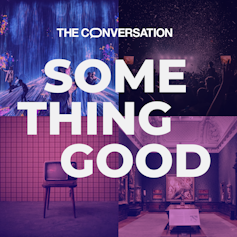(L-R) Bram Stoker, Taylor Swift and Mary Shelley. Wiki Commons/Disney+
Matthew J.A. Green, University of Nottingham
Taylor Swift has cultivated a global brand that might seem incompatible with the darkness, abjection and monstrosity of gothic fiction. But, beneath the friendship bracelets and sequins, her global Eras Tour makes extensive use of gothic elements to engage her audience and articulate her feminist politics.
From our partners:
Her elaborate set designs, for example, incorporate subjects common to gothic art and use contrasting light and shadow and exaggerated perspectives to depict the sublime and the supernatural. Swift’s costumes, meanwhile, transform images of monstrous femininity – the lamia, the witch, the madwoman – into symbols of empowerment.
The potency and global reach of Swift’s creations demonstrate not only the gothic genre’s pervasiveness but its renewed cultural relevance. Her use of the genre has even provoked right-wing accusations that she performs dark magic.
The gothic tradition was made famous by novelists like Ann Radcliffe and Mary Shelley. Writing during the industrial revolution, their popular novels used desire, the supernatural and the sublime to ask questions about gender, power and personal freedom. Like these writers, the value of Swift’s work is often undervalued due to biases over gender and genre, but she too references and develops a rich literary tradition.
Her latest album, The Tortured Poets Department (2024), includes several forays into the literary gothic. While tracks like The Albatross and The Black Dog rework imagery from Samuel Coleridge and British folklore, the Fortnight video references Shelley’s Frankenstein.
In May, when Tortured Poets was incorporated into the tour, Swift designated this new era “Female Rage The Musical”. On stage, Swift performs Fortnight in a literary asylum, and in Who’s Afraid of Little Old Me? she levitates beneath a giant screen depicting a haunted house, which eventually shows her face with glowing eyes and a morbid pallor.
A monstrous Reputation
Swift’s personal experiences of misogyny have led her to explore what film scholar Barbara Creed calls “radical abjection”. This concept reinterprets “the monstrous-feminine as a figure who embraces abjection … while questioning patriarchy, anthropocentrism, misogyny and the meaning of the human”.
In 2016, Swift was derided repeatedly by Ye (the rapper formerly known as Kanye West), who released a video of himself in bed with a naked Swift lookalike. She was accused by many social media users of being a “fake” and a “snake”.
The album Reputation (2017) was her response, asserting her power as an artist revelling in monstrous femininity. It spoke to Swift’s growing awareness of her position as a woman in a patriarchal culture. On I Did Something Bad, she sings: “They’re burning all of the witches / Even if you aren’t one.”
The video for Reputation’s lead single, Look What You Made me Do, shows her as both a zombie and a snake queen. Ready For It stages a cyber-gothic battle between the apparently real Swift and her artificial doppelgänger, before revealing that both are, in fact, androids.
These videos further support research on Swift’s exploration of the self in her music. Through these songs and their videos, she shows that our identities are multifaceted and constructed. But she also continues to value authenticity and community.
“We are mosaics of our worst selves and our best selves,” Swift argues in Reputation’s liner notes. The authentic self, she suggests, exists “somewhere between our well-lit profile photo and our driver’s license shot”.
Gender identity and the power of ‘Swift gothic’
Medievalist Holly Crocker draws a connection between the gender-based bias depicted in William Langland’s allegorical poem Piers Plowman (c. 1380) and Swift’s songs. This suggests another parallel between her work and that of classic gothic novelists like Radcliffe. Writing in the romantic period, Radcliffe used the trappings of medieval Europe to explore female subjectivity at a time when political, economic and intellectual upheavals were re-framing what it meant to be human.
In concert, Swift’s use of the gothic to explore gender and subjectivity has one advantage unavailable to her literary precursors: the power of her music to enhance the emotions and sense of self through audience participation. Eras creates an almost unprecedented feeling of community and acceptance, allowing fans to explore different facets of themselves as they sing and dance along together.
I recently undertook an unofficial research trip to see Eras in Edinburgh. Irrespective of age, gender or body-type, many concertgoers turned out in gothic garb, ranging from Reputation’s snake-patterned bodysuit to Willow’s witch cowls to Folklore’s gothic foliage.
The high point for myself – and for my 13-year-old chaperone – was an acoustic rendition of Tortured Poets track The Bolter, which was inspired by the unconventional life of English aristocrat Idina Sackville (1893-1955).
Combining critique with feminist biography, “Swift gothic” is more than simply the latest development in one of our most cherished literary traditions. It has also corresponded with an exponential increase in Swift’s popularity, commercial success and cultural power.
With unprecedented global reach, Swift gothic addresses audiences with deep questions about selfhood and culture. Speaking to us with pervasiveness and power, Swift’s works are every bit as profound, significant and foundational as Radcliffe’s Mysteries of Udolpho, Shelley’s Frankenstein and Bram Stoker’s Dracula.

Looking for something good? Cut through the noise with a carefully curated selection of the latest releases, live events and exhibitions, straight to your inbox every fortnight, on Fridays. Sign up here.![]()
Matthew J.A. Green, Associate Professor in Literature and Popular Culture, University of Nottingham
This article is republished from The Conversation under a Creative Commons license. Read the original article (https://theconversation.com/why-taylor-swifts-gothic-work-is-as-important-as-the-novels-of-mary-shelley-or-bram-stoker-233518).
For enquiries, product placements, sponsorships, and collaborations, connect with us at hello@zedista.com. We'd love to hear from you!
Our humans need coffee too! Your support is highly appreciated, thank you!

